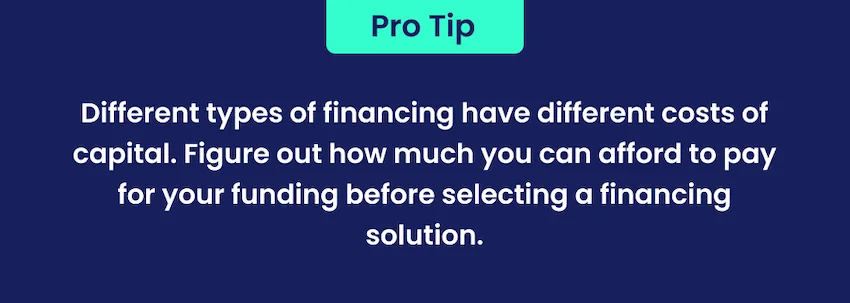Starting an eCommerce business is thrilling, but it needs capital to grow. Not everyone has enough savings to support their online dream. That’s why many turn to funding.
You see, all too often, eCommerce entrepreneurs face a cash flow crunch. This frequently occurs because the costs of procuring inventory and running a business are often due well before revenue starts rolling in from sales. Therefore, sellers need a way to secure external capital in order to stock up on inventory and keep their business running strong.
The good news is that there are tons of funding options out there, from regular bank loans to new methods like eCommerce financing or crowdfunding. Sorting through the various options can be overwhelming, and picking the right one for your needs can be challenging. Without the right information, it’s all too easy to get confused or make the wrong choice.
So, before you seek funding, consider these six crucial questions to pick the right funding solution for your online venture:
- What do I need funding for?
- How much funding do I need?
- How much can I afford to pay for funding?
- What repayment schedule and terms best suit my business?
- Am I willing to give up equity?
- What type of funding am I eligible for?
Read on to discover which funding path is best suited to your unique business needs!
1. What do I need funding for?
First off, be crystal clear on why you need funds. Different needs call for different solutions, and you want to make sure you’re looking in the right places.

Inventory:
If your online store’s shelves are emptying out and you need to stock up on inventory, certain funders specialize in helping you do just that. Inventory financing is designed specifically for retailers who need extra funds to help them procure inventory and avoid stockouts. If you are in search of capital for inventory, it’s a good idea to look into these funders.
Launching something new or expanding
Launching a new product or expanding your business can take a pretty hefty sum of capital. Banks and traditional lenders aren’t always willing to give out such large loans, especially to online businesses. Instead, you may want to turn to funders tailored to eCommerce. They understand the unique challenges and opportunities of selling online and are ready to assist you in any way they can.
Selling on popular platforms
Big names like Amazon and Shopify aren’t just sales platforms. They also offer specialized funding options for their sellers. So, if you’re one of their many sellers, it’s worth checking out.
Amazon Lending offers sellers on the platform several funding options, including term loans, lines of credit, and even a merchant cash advance. However, the program is invite-only and depends on your account standing.
Shopify Capital provides fast funding for Shopify sellers based on their sales. You can apply directly through the platform, and it’s fully integrated with your Shopify store.
Other specific needs
Maybe you need a cash boost for a marketing campaign, or perhaps you’re facing a temporary cash squeeze. Pinpointing your exact requirements will help you target the right funding source.
Additionally, there’s a whole world of funding sources out there, ready to invest in promising ventures.
These include your classic bank loans, which have been the go-to for businesses for ages, venture capital if you’re eyeing rapid growth and expansion, and even crowdfunding platforms.
Every funding option comes with its own unique terms, and you need to ensure it aligns with your business’ needs. Avoid generic one-size-fits-all options. Tailoring your choice to your exact needs will likely land you a better deal and smoother sailing ahead.
2. How much funding do I need?
Sometimes all you need is a bit of cash to keep things running smoothly. In cases like these, a business line of credit might be your best friend.
If you’re gearing up for something big, like stocking up on inventory before the Q4 sales rush or launching a new product, you’ll need a different solution. In this case, you’d want to look at sources that offer a substantial amount of funding.
What determines the amount you’ll need?
Think about:
- Your business’s size: Naturally, a larger operation might need more funds.
- What you do: The kind of business you run affects your funding requirements.
- Your future plans: If you have big growth plans, you’ll need the money to support them.
Once you’ve got a number in mind, you can start exploring places that provide that kind of money. It’s easier to narrow down your choices once you know how much money you’re looking for.
3. Can I afford it?
When considering funding for your business, it’s important to fully understand how different options will impact your finances.
Different types of financing have different costs of capital as well as different repayment structures. Before choosing a financing partner, figure out how much you can afford to pay for your funding.

Make sure you fully understand the cost of each funding solution you are considering. For example, if you are taking out a traditional loan from a bank, you get a lump sum of cash which you pay back with interest. Before signing on the dotted line, figure out how high your monthly repayments will be. Then, figure out if you’ll still have an acceptable profit margin after making those payments.
If you’re looking into an alternative form of financing, such as a merchant cash advance or revenue-based financing, you’ll repay your lender with a percentage of your revenue. Seriously consider whether this percentage fits into your long-term financial plan. Also be sure to check for hidden fees, which can pop up unexpectedly.
Before you decide on any funding option, you need to ensure you can handle the repayments without stretching your budget too thin. By staying mindful of your profit margins and business costs, you’ll avoid overextending and shield your enterprise from potential financial perils.
4. What repayment schedule and terms best suit my business?
Make sure you understand the various terms and conditions of each funding solution before selecting one. These may include:
Payment due dates and grace period:
You should know exactly when your first payment is due and the total time you have to settle the funding completely.
Interest rate structure:
If you are getting interest-based funding, there can be two types of interest rate structures: fixed rates and variable rates.
In a fixed rate structure, your interest rate won’t change, giving you predictable repayments.
The variable rate structure is more dynamic. Rates might fluctuate based on market conditions. They can be beneficial if rates decrease, but there’s also a risk if they climb.
Frequency of repayments:
Some funders might want repayments daily, while others may demand weekly or monthly repayments. This can affect your cash flow, so choose a plan that aligns with your business’s income frequency.
Mode of repayment:
Depending on your business structure and sales forecast, you may want to consider a more flexible funding option. Bank loans, for instance, usually require regular, fixed repayments. This can be a huge challenge for online sellers with fluctuating or seasonal sales.
With revenue-based financing, when you make more sales, you pay more, and when sales are slow, your repayments scale down accordingly.
Merchant cash advance financing is similar but typically tied to your card sales. It’s a flexible approach where repayments are directly based on your sales.
Diving deep into the details might seem tedious, but it’s essential. Like in any partnership, you want to understand the terms of your relationship with your funder. Knowing these ins and outs ensures you’re not caught off-guard, and you can build a successful, sustainable business.
5. Am I willing to give up equity?
When you’re searching for ways to finance your business, one major consideration is whether you’re open to giving up equity. Some investors, including angel investors and venture capitalists, provide funds in return for a portion of ownership in your business.
Think of your business as a cake. Each slice of that cake represents ownership. If you opt for equity financing, you’re essentially handing over some slices (or ownership portions) to your investors.
On the flip side, there are financing options, like 8fig, that provide funds without asking for a slice of your cake, meaning you retain full ownership.
It’s crucial to deeply reflect on this. While giving up equity can bring in significant funds and possibly valuable partnerships, it also means sharing decision-making power and future profits. Not every entrepreneur is comfortable with this trade-off, so weigh your options carefully.
6. What type of financing am I eligible for?
Your credit score and business history play pivotal roles in determining your funding options.
Traditional lenders, like banks, typically emphasize a robust credit history. If your credit score isn’t up to par, these avenues might not be available to you.

Contrastingly, some alternatives like merchant cash advances are more interested in your current sales volume than past financial missteps.
Many funders also require a significant sales history before agreeing to fund your business. For startups or businesses still in their infancy without consistent revenue, these funding sources might be out of reach.
Before investing time in any funding application, ensure you understand the prerequisites to increase your chances of approval.
Choosing an ECommerce Financing Partner
Starting and growing an eCommerce venture is a journey filled with excitement and challenges. While establishing an online empire can be thrilling, the reality is that scaling and maintaining such a venture demands financial resources.
While there are numerous funding avenues available, you must identify the one that best aligns with your business needs and capabilities.
Once you understand the financial needs of your business, you’ll be able to make more informed funding decisions.
If you’re an eCommerce business owner looking for funding designed specifically for your needs, 8fig might just be the solution you’ve been seeking.
For eCommerce businesses earning over $100,000 annually, 8fig offers equity-free funding tailored to your supply chain needs. Instead of one lump sum payment, you’ll get continuous cash injections aligned to your unique supply chain costs. This maximizes your cash flow to ensure consistent stock levels and growth potential. Plus, it’s flexible. As your needs evolve, so does your funding plan.
Join the ranks of online stores we’ve helped reach 8-figure revenues with our AI-driven funding. Apply now and find out how 8fig can help your eCommerce business reach its full potential.
to our blog
Read the latest
from 8fig

From AI-powered styling to virtual try-ons, learn about the innovations transforming the fashion industry and enhancing the shopping experience.

Explore the pros and cons of lump sum loans vs. just-in-time funding, and discover why JIT funding could be the game-changer your eCommerce business needs.
![BFCM: The ultimate guide to eCommerce sales [2024]](https://www.8fig.co/wp-content/uploads/2023/09/cover-2-768x432.jpg.webp)
Get ready for Black Friday and Cyber Monday with our guide on maximizing sales through smart inventory management, effective marketing strategies, and leveraging eCommerce financing.
